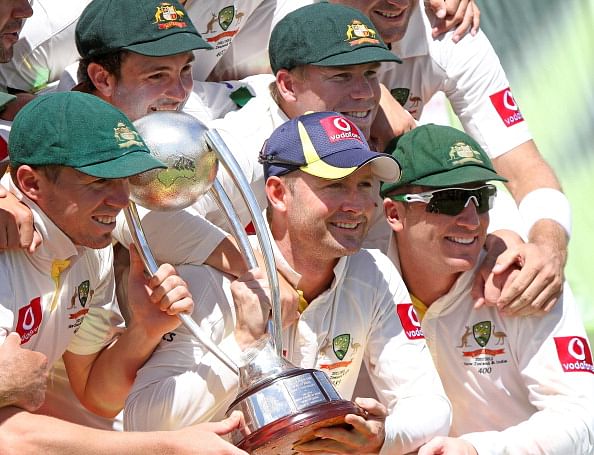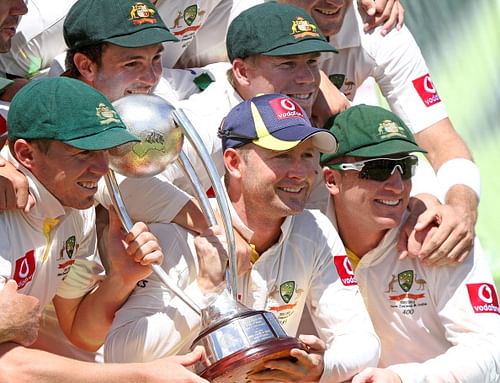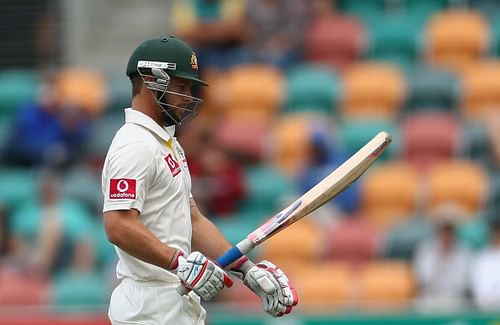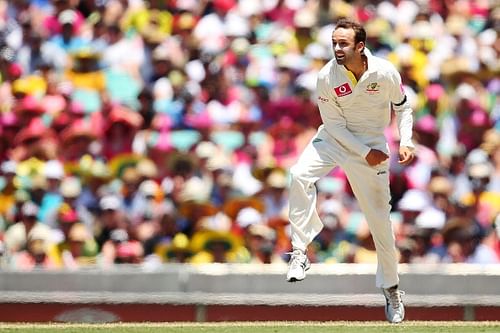
Border-Gavaskar trophy: How real is India's 'real test'?

Michael Clarke’s men clinched the Border-Gavaskar Trophy comfortably last year. Can they repeat it this time?
It’s almost time for another Test season in India and the familiarity of this phase, one week before the beginning, has already started dawning upon us. A few days of badmouthing the selections, followed by a few days of exclusive discussion by innumerable expert panels and an inevitable end to this ritual in the form of Harbhajan Singh‘s lofty predictions- all the makings of a home series are in place.
Of late, exuberant advertising campaigns have been inducted into this ritual as well. This time, however, the campaign seems to be a little sedate. In fact, judging by the angrezon ki pungi yardstick, it almost exhibits a sense of fear when Kapil Dev says Australia is the real deal and the ultimate test.
Does that reflect the mindset of the broadcasters after the irony of the last three campaigns or that of the team itself?
If it is the latter, then the team’s various consultants aren’t doing a good job.
The Australian team, for the most part, has had one thing going for them consistently, and that is the batting form of Michael Clarke. What conceals the fact that the rest of the team hasn’t been all that good, is a decent bowling attack. That being said, one must also consider that this bowling attack hasn’t been exposed to much of a challenge – most of Australia’s recent wins have been at home and against very average oppositions.
It is common knowledge to touring teams in India that the batsmen win you games here. This Australian pace attack could well have skittled India out at home, but their influence in these conditions will be highly dependent on the display of their batsmen; and on that front, lies Australia’s biggest challenge.
There’s no two ways about it. Australia’s batting is top heavy and works well for them, with India’s long struggle of putting together a competent international pace attack still raging. However, if the practice games are anything to go by, they shouldn’t be counting on facing too much pace on this tour, but should be wearing dust masks while batting!
Shane Watson put together a couple of good counter-attacking displays against the spinners and we all know David Warner will follow suit. It is a strategy that could work for Australia’s high-quality players; but in cricket, as it is in life, maintaining a positive demeanour over long periods of time is an ability very few are born with and only a handful can master through practice. If history is anything to go by – and Harbhajan Singh’s inclusion in the Indian team should suggest that it is – time has always played elongated tricks with the Australians in this part of the world.
Mahendra Singh Dhoni made no secret of his desire to blow England away with spin when they came visiting a couple of months ago. Unfortunately for him, the quality of the spinners at his disposal was no match to that of England’s batsmen and, indeed, that of their spinners. A sizeable chunk of this failure was down to the skill and temperament of England’s middle order and some valuable knocks from Matt Prior. They didn’t show too much brilliance, but their persistence was key to the prowess of their in-form top order giants.
On drawing a parallel between the two line-ups, one wonders if the Australian middle order can replicate; especially, without the mastery that Michael Hussey used to bring to the various roles involved in that crucial rung of Test batsmanship.
In all likelihood, Warner and Cowan will make up the opening pair for Australia, hence accommodating Watson either at number three or slightly lower down, depending on whether Hughes continues to be favoured. Either way, the top order looks world class. However, Matthew Wade will most certainly be coming in at number six and that is where Australia’s problems could begin.

Matthew Wade has a lot of weight on his shoulders.
Wade has only been around in international cricket for about a year now and in the 32 One-Day games, 17 T20s and 9 Tests that he has played, he hasn’t shown signs of being anything more than a decent batsman. He comes to this tour on the back of a century at number six, in Australia’s last Test against Sri Lanka, followed by a string of poor performances in the One-Dayers that followed against the Lankans and the West Indians.
If things don’t start looking up for him, he could end up as the source of some calamitous collapses, given that the man immediately following him is inevitably going to be a young all-rounder on his debut Test tour. You wouldn’t expect an Australian cricketing mind to be deterred by such thoughts; but then again, no one did when Australia last toured under Ricky Ponting. If you slam the floodgates hard enough, you could warp it to allow the tiniest bit of seepage.

There is tremendous amount of pressure on a lot of Australia’s inexperienced players at the moment. On the very top of that list are their spinners, the reason being that ephemeral success and lucrative IPL deals apart, they are – to put it simply – very average spinners. Nathan Lyon, who poses a respectable amount of problems to non-Asian batsmen, could well seem pedestrian to India’s line-up. Should that be the case, and Australia consider going in with a second spinner at the expense of a frontline pacer, India’s record of five wins in their last 16 Tests (two each against West Indies and New Zealand) will be forgotten quicker than any potential Sehwag century.
Is India really the team facing the ‘ultimate test’? I would think not.